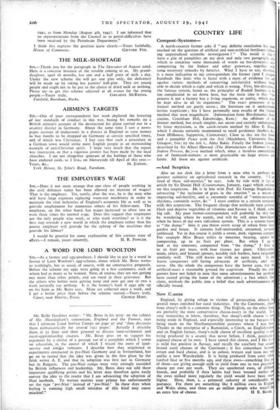A north-country farmer asks if "any definite conclusion has b ozo
reached on the question of artificial and non-artificial fertilisers follow. ing unprejudiced scientific investigation ?." The result is that I have a pile of pamphlets on my desk and only two paragraphs into which to Condense some thousands of words on bio-dynamics, soil. composting by the Indore and other processes, together aith some necessary remarks by heretics. What I have to say, therefor; is a mere indication to my correspondent the farmer (and I imagist hundreds like him) who is faced with a mass. of evidence for and against variotr: methods of conserving soil-fertility without being able to decide which is right and which is wrong. First, bio-dynamics; the famolis system, based oh the principles of Rudolf Steiner, is fat too complicated to set down here, but the main idea is that "the process is not a factory but. a living organism, or entity, which must be kept alive in all its organisms." The exact processes of the Steiner method are partly secret; the literature on it undoubtedly invites scepticism ; but I have personally seen results of the Steiner method that were magnificent. (Information from Bio-dynamic Asth. ciation, Crockham Hill, Edenbridge, Kent.) An offshoot of the Steiner method, but much simpler, not secret and entirely unhampered by lunar mysticism, is the wick-return method by Miss E. Bruce, which I should certainly recommend to small gardeners (leaflets, &c, from Hillhouse, Sapperton, Cirencester). Close to this are the books and a pamphlet Peace with the Soil (Maclehose, University Press, Glasgow, free) by the late C. Alma Baker. Finally the Indore process, described by Sir Albert Howard (The Manufacture of Humus by the Indore Process, &c.)—a method which, since it involves considerable use of farmyard-manure, is most practicable on large estates and farms. All these are against artificials.


































 Previous page
Previous page